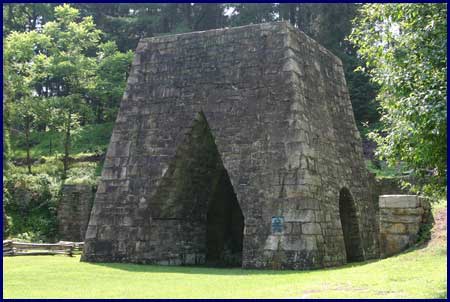Iron and Industrial Archaeology
Iron-making began in Pennsylvania as early as 1720 and evolved into a key industry because of the abundance of high-quality iron ore, limestone, and trees in the Commonwealth. Iron furnaces were located near these raw materials, and so-called company towns grew around the furnace complexes. Such towns were owned, operated, and controlled by the company and served as a means to attract workers to the rural areas where most furnaces were located. Both skilled and unskilled workers were required for the iron-making process, including woodcutters and colliers who made charcoal for fuel, miners who produced the iron ore, furnace workers, and support workers such as a blacksmith, carpenters, and office clerks. Furnace owners provided homes, a company store, churches, and schools. Social and economic status varied depending on the job of each worker, with miners enjoying relatively high status and teamsters and unskilled workers ranking relatively low. Distinct neighborhoods in company towns were established for people of similar social status.
Advances in technology resulted in the closing of most iron furnaces in the late 19th century as iron production moved to industrial centers such as Pittsburgh where steel was forged. Many of the stone furnace stacks can still be seen in Pennsylvania today. Hopewell Furnace and Cornwall Iron Furnace are fine examples that have been preserved as historic sites. Archaeological studies have been conducted at a number of iron furnaces, including Cornwall Iron Furnace in Lebanon County, Joanna Furnace in Berks County, Hopewell Furnace in Berks County, Sarah Furnace in Blair County, and Greenwood Furnace in Huntingdon County. Investigations have focused both on the iron furnaces and on the houses of owners and workers. Artifacts from the houses can be compared to those from houses of farmers and tradesmen to identify differences in economic and social status. Indicators of status include the size and construction of the residence, the quality and cost of ceramic tableware, and the quality of meat cuts represented by bone refuse. Indicators analyzed from the Sarah Furnace revealed a relatively low economic status consistent with historic documents indicating that ironworkers were poorly paid.

A reconstructed furnace stack at Greenwood Furnace
The coal mining industry was also very significant in Pennsylvania throughout the later 19th and early 20th centuries. Bituminous or "soft coal" is found in abundance in the central and southwestern parts of Pennsylvania while the largest deposit of anthracite or "hard coal" is found in a five hundred square mile area of northeastern Pennsylvania. Workers in this industry - many of them unskilled immigrants - often experienced harsh and unsafe working conditions, poor wages, company dominance, accidents, disasters, and occupationally-related disease. Like iron industry workers, many 19th century coal miners also lived in company towns. One example is Eckley Miners' Village, located in Weatherly, approximately seven miles northeast of Hazleton. Construction of the town began in 1854 and eventually included a company store, butcher shops, schools, churches, a doctor's office, and over 150 tenements that included gardens and out-buildings. The PHMC owns this historic property, and it serves as a living museum.
Archaeological investigations have revealed important information about Eckley and the lives of mineworkers and their families. Uncovered artifacts ranged from children's toys to smoking implements to scraps of clothing. Artifacts from the front, side, and rear yards were contrasted to determine how yard space was used by the occupants. Front and side yards generally contained higher percentages of artifacts related to recreation and smoking, reflecting their use as sites for leisure activities. The rear yards, in contrast, had higher percentages of artifacts related to cooking activities. This pattern reflects the location of summer kitchens, which were frame buildings with coal stoves that were used when the weather was too hot for indoor meal preparation.

Excavations at House Lots #117/119 Main Street, conducted in 1991
Brick making was another important 19th-century industry where archaeological investigations have provided important information. At the Harmony Brickworks near Pittsburgh, archaeological investigations uncovered a wealth of data about the layout and technology of the brick manufacturing enterprise. Fieldwork uncovered three hot floors that circulated hot air to dry the clay bricks before they were baked. Seven kilns were also found. The investigations at the Harmony Brickworks documented a process that has been only sparsely recorded in the historical record.